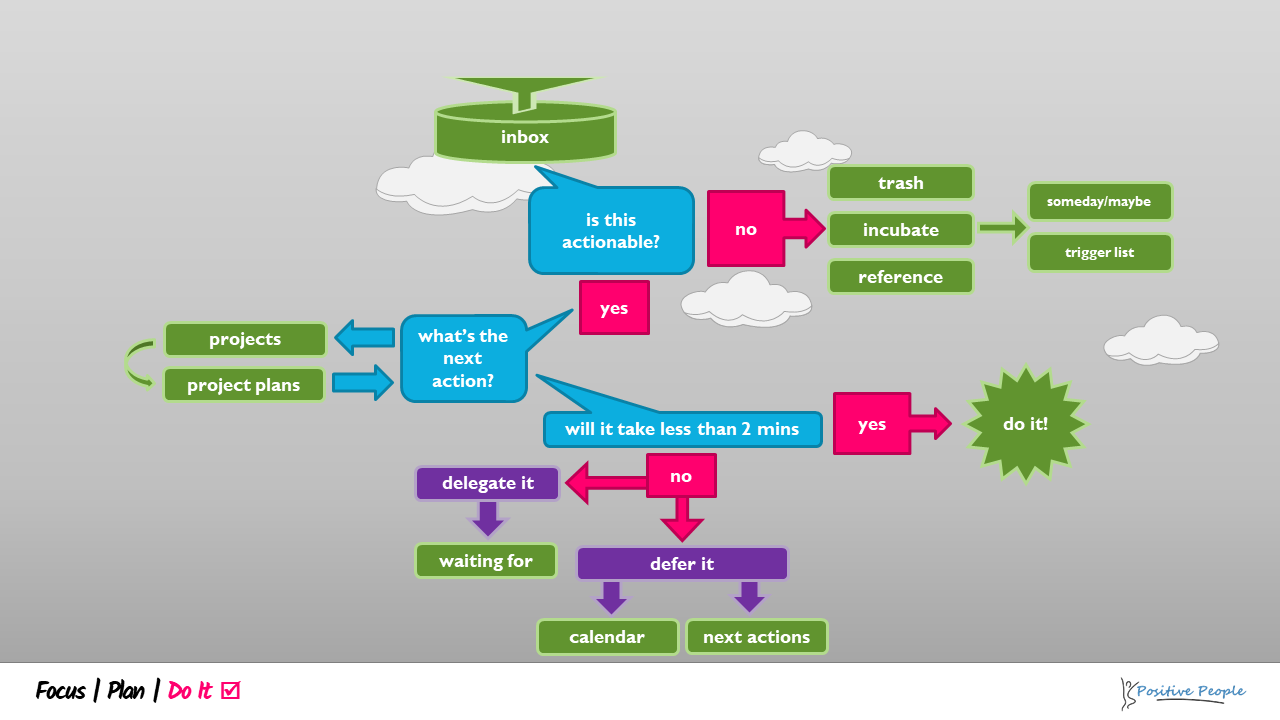Having captured, we need to process each item; defining the meaning and being clear on the next action. It’s easy to skip this phase of workflow; jumping from phase 1 (capture) straight to phase 3 (organise). When this step is skipped, the results are an unclear system and loss of trust. For everything captured, ask yourself:
- What is the next action?
- Is this a phone call I should make?
- Is it an email I need to send?
- Is it a task or a project?
- Is it urgent, or is it something I haven’t truly committed to yet?
In the heat of the moment when we captured, the next action and related project may have not been identified.
For this exercise, first jot down as many next action verbs as you can think of (call, speak to, email, buy – there’s 4 to get you started).
How many did you come up with? (Did you include ‘delete’ in your list of verbs?)
For every item that is captured, simply ask what’s the verb that applies to this? This should be done frequently so that our capture tools are zeroed on a regular basis. Many of them would benefit from daily processing; others can possibly be handled weekly. However, as hotspots develop around our home, on top of the microwave, in our bags, pockets and glove compartments, we begin to lose trust in the system. So be rigorous with this phase.
The workflow chart below can be helpful – you might want to print out the version in the exercise and keep it handy as you begin to implement the material.
Use the icons on the interactive map below for more information
Thinking is the hardest work there is, which is probably the reason so few engage in it.
Henry Ford Tweet

The Next Action list (or To-Do list) is for items that may have a due date or deadline but can be fitted around meetings.
Pro Tip:
- Use action verbs and enough detail to make your list meaningful.
- If possible, use a system to filter your tasks.
- By area/project – Admin, Finance, Office Move, etc.
AND / OR
- By context – Agenda (Boss), Home, Braindead, etc.
- By area/project – Admin, Finance, Office Move, etc.
Videos: Microsoft To Do or Google Tasks.
1 of 15This is the “hard landscape” of your day – meetings, appointments and events.
Pro Tip:
- Don’t litter the calendar with all all of your tasks.
- Pitfalls are double-booking and continual rescheduling.
- However, it’s good practice to block time in the calendar for bigger pieces of work.
- This stops back-to-back meetings soaking up all your available time.
If you own part of the project, but someone else has the Next Action, track it in your system.
Pro Tip:
Video: Microsoft Outlook Waiting For trick.
3 of 15If the item is more than a single step, there is now likely a linked project.
Create a section in your task system to map it (E.g. MS. Planner, Trello, Asana, Google Keep).
Videos: Microsoft OneNote and Google Keep.
4 of 15Longer than Two Minutes
- The item will need to be deferred or delegated if:
- It will take longer than two minutes
- You are not in the right location
- You don’t have the needed energy or other resources
Secondary electronic tools
- SMS
Pro Tip:
Determine which sources are outside your ‘main system’ and invest time to see if they can be connected.
- Check out services such as IFTTT (If This Then That), Zapier and Microsoft Power Automate.
Phone calls
- Can be difficult if you use your phone as your capture tool.
Pro Tip:
- Ask the caller to follow up with an email or
- Capture electronically immediately after the call (send quick email to self, Braintoss, etc.)
- At very least, quick scribble on a post-it
Core electronic inputs
- Email (multiple mailboxes)
- Trello,
- MS Teams chat, Google chat, etc……………
Pro Tip:
Have as few of these as possible and get them to empty frequently.
8 of 15Letters
Official documents, expense receipts and other hard copy material.
Pro Tip:
- Set up a home scanner to scan straight into OneNote (or Google docs, Evernote, etc.)
- To do this in OneNote, visit “Save emails to OneNote“
For expenses, photograph them to file system (OneDrive, Google docs, Expensify, etc.)
9 of 15Face to Face inputs
- Meetings
- Consider using Microsoft OneNote to capture and collaborate in meetings
- Informal (hallway, canteen, car park, etc.)
- Where appropriate consider asking the person to send an email so the item is captured formally
- (ask yourself what happens if they forget – if you are still on the hook, you will want to capture it.
10 of 15 The ‘age of clutter’
- Get rid of inputs that are irrelevant and will never be required.
- However, be clear on your organisation’s data retention policies.
- Keep things you might need for future reference.
- Delete things you should (FOI, GDPR, etc.)
This includes good ideas for the future but with no commitment.
- This avoids the task list becoming ‘clogged up’ with future ideas that simply need consideration.
- Give it a trigger or reminder if there is a closing date to the opportunity.
If the action has already been completed or it supports an action, it needs to be retained.
- For many, their email client is a large part of their filing system
Pro Tip:
Dramatically reduce the use of email folders. Instead, become familiar ‘search’
- Research has shown that time spent filing emails can far exceed the occasions where additional searching is required.
- Emails could be relevant in multiple folders
- Folders quickly go out of date as roles and projects change.
The 2-minute rule is good guide – if something takes less than two minutes, don’t write it on a to-do list; get it done and it will never clutter up your life again.
Pro Tip:
- Although the two-minute rule is generally useful, there are a couple of warnings:
- Work is often underestimated (be more realistic).
- The entire day can be filled with two-minute tasks while avoiding the big thing. Be conscious of this.
During the capture process, the next action may not have been correctly identified.
- Ask what is the very next action that will move this thing along.
- Consider using the OHIO approach (Only Handle It Once) to reduce duplication and over-thinking.
Expert Tip:
“Next Action” thinking improves the quality of:
- To Do Lists.
- Meetings.
- Everyone in the meeting (chair, participants, minute-taker) should get into the habit of asking “what is the next action?”
